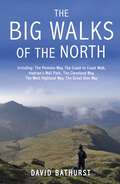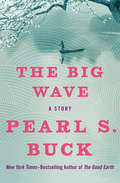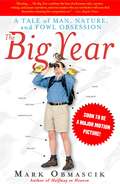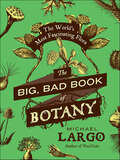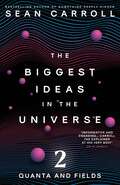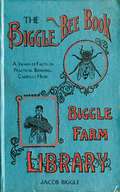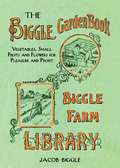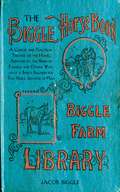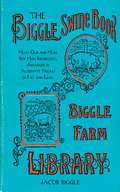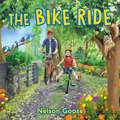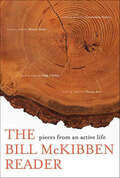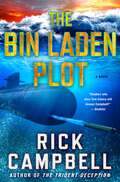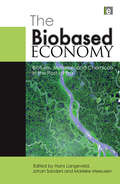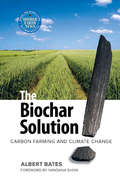- Table View
- List View
The Big Walks of Great Britain
by David BathurstAn indefatigable walker, David Bathurst has unlaced his boots to produce this invaluable companion to the fifteen best-loved long-distance footpaths of Great Britain. His appreciation of the British countryside and light-hearted style will appeal to novice and experienced walkers alike.
The Big Walks of Great Britain
by David BathurstAn indefatigable walker, David Bathurst has unlaced his boots to produce this invaluable companion to the fifteen best-loved long-distance footpaths of Great Britain. His appreciation of the British countryside and light-hearted style will appeal to novice and experienced walkers alike.
The Big Walks of the North
by David BathurstDavid Bathurst has unlaced his boots to produce this definitive companion to the ten best-loved long-distance footpaths in the north of Britain, with each split into manageable sections. Combining detailed descriptions with an appreciation of the beauty and history of the British countryside, this in an indispensable guide for all walkers.
The Big Walks of the North
by David BathurstDavid Bathurst has unlaced his boots to produce this definitive companion to the ten best-loved long-distance footpaths in the north of Britain, with each split into manageable sections. Combining detailed descriptions with an appreciation of the beauty and history of the British countryside, this in an indispensable guide for all walkers.
The Big Walks of the South
by David BathurstDavid Bathurst has unlaced his boots to produce this definitive companion to the ten best-loved long-distance footpaths in the south of Britain, with each split into manageable sections. Combining detailed descriptions with an appreciation of the beauty and history of the British countryside, this in an indispensable guide for all walkers.
The Big Walks of the South
by David BathurstDavid Bathurst has unlaced his boots to produce this definitive companion to the ten best-loved long-distance footpaths in the south of Britain, with each split into manageable sections. Combining detailed descriptions with an appreciation of the beauty and history of the British countryside, this in an indispensable guide for all walkers.
The Big Wave
by Pearl S. BuckThe classic tale of a Japanese boy orphaned by a tsunami from the author of The Good Earth, the first American woman to win the Nobel Prize in Literature. On a mountainside in Japan, two boys enjoy a humble life governed by age-old customs. Jiya belongs to a family of fishermen; his best friend, Kino, farms rice. But when a neighboring volcano erupts and a tidal wave swallows their village—including Jiya&’s family—life as they know it is changed forever. The orphaned Jiya must learn to come to terms with his grief. Now facing a profoundly different life than the one he&’d always taken for granted, he must decide on a new way forward. Written with graceful simplicity, The Big Wave won the Children&’s Book Award of the Child Study Association of America when it was first released. This ebook features an illustrated biography of Pearl S. Buck including rare images from the author&’s estate.
The Big Year: A Tale of Man, Nature, and Fowl Obsession
by Mark ObmascikEvery year on January 1, a quirky crowd of adventurers storms out across North America for a spectacularly competitive event called a Big Year -- a grand, grueling, expensive, and occasionally vicious, "extreme" 365-day marathon of birdwatching. For three men in particular, 1998 would be a whirlwind, a winner-takes-nothing battle for a new North American birding record. In frenetic pilgrimages for once-in-a-lifetime rarities that can make or break their lead, the birders race each other from Del Rio, Texas, in search of the rufous-capped warbler, to Gibsons, British Columbia, on a quest for Xantus's hummingbird, to Cape May, New Jersey, seeking the offshore great skua. Bouncing from coast to coast on their potholed road to glory, they brave broiling deserts, roiling oceans, bug-infested swamps, a charge by a disgruntled mountain lion, and some of the lumpiest motel mattresses known to man. The unprecedented year of beat-the-clock adventures ultimately leads one man to a new record -- one so gigantic that it is unlikely ever to be bested...finding and identifying an extraordinary 745 different species by official year-end count. Prize-winning journalist Mark Obmascik creates a rollicking, dazzling narrative of the 275,000-mile odyssey of these three obsessives as they fight to the finish to claim the title in the greatest -- or maybe the worst -- birding contest of all time. With an engaging, unflappably wry humor, Obmascik memorializes their wild and crazy exploits and, along the way, interweaves an entertaining smattering of science about birds and their own strange behavior with a brief history of other bird-men and -women; turns out even Audubon pushed himself beyond the brink when he was chasing and painting the birds of America. A captivating tour of human and avian nature, passion and paranoia, honor and deceit, fear and loathing, The Big Year shows the lengths to which people will go to pursue their dreams, to conquer and categorize -- no matter how low the stakes. This is a lark of a read for anyone with birds on the brain -- or not.
The Big and Awesome Bridges of Portland and Vancouver: A Book for Young Readers and Their Teachers
by Sharon Wood Wortman Ed WortmanThe big & awesome bridges of Portland & Vancouver is a book that gets young people excited about science and engineering and provides teachers a comprehensive resource for developing engaging elementary school units of study, all through an exploration of one of the most diverse and historic collections of big river bridges in the world.
The Big book of Serial Killers
by Jack RosewoodThese serial killers are not mythical beasts with horns and shaggy hair. They are people living among society, going about their day to day activities until nightfall. They are the Dennis Reader's, the fathers, husbands, church going members of the community.
The Big, Bad Book of Beasts: The World's Most Curious Creatures
by Michael LargoThe world's wildest collection of animal knowledge and lore!Lions, and tigers, and bears . . . and dinosaurs, dragons, and monsters. Oh my!For hundreds of years, the most popular books in the Western world next to the Bible were "bestiaries," fanciful encyclopedias collecting all of human knowledge and mythology about the animal kingdom. In these pages, eagles and elephants lived next to griffins and sea monsters. Now, in The Big, Bad Book of Beasts, award-winning author Michael Largo has updated the medieval bestsellers for the twenty-first century, illuminating little-known facts, astonishing secrets, and bizarre superstitions about the beasts that inhabit our world—and haunt our imaginations. You'll learn about the biggest bug ever, the smallest animal in the world, and the real creatures that inspired the fabled unicorns. You'll discover how birds learned to fly, why cats rub against your legs, and a thousand other facts that will make you look at nature in a wonderfully new way.Did you know?The fastest animal in the world is the peregrine falcon, which reaches speeds of over 200 miles per hours.Circus ringmaster P.T. Barnum fooled many when he displayed a "mermaid" carcass that was later proved to be monkey bones sewed together with the body of a fish.Discovered in a remote volcanic crater in New Guinea, the Bosavi wolly rat grows to the size of a cat.President Andrew Jackson bought an African gray parrot to keep his wife company. The bird outlived them both and was removed from Jackson's funeral for cussing in both English and Spanish.A to Z: From Aardvark to Zooplankton!For all ages!Includes 289 illustrations!
The Big, Bad Book of Botany: The World's Most Fascinating Flora
by Michael LargoDavid Attenborough meets Lemony Snicket in The Big Bad Book of Botany, Michael Largo’s entertaining and enlightening one-of-a-kind compendium of the world’s most amazing and bizarre plants, their history, and their lore.The Big, Bad Book of Botany introduces a world of wild, wonderful, and weird plants. Some are so rare, they were once more valuable than gold. Some found in ancient mythology hold magical abilities, including the power to turn a person to stone. Others have been used by assassins to kill kings, and sorcerers to revive the dead. Here, too, is vegetation with astonishing properties to cure and heal, many of which have long since been lost with the advent of modern medicine.Organized alphabetically, The Big, Bad Book of Botany combines the latest in biological information with bizarre facts about the plant kingdom’s oddest members, including a species that is more poisonous than a cobra and a prehistoric plant that actually “walked.” Largo takes you through the history of vegetables and fruits and their astonishing agricultural evolution. Throughout, he reveals astonishing facts, from where the world’s first tree grew to whether plants are telepathic.Featuring more than 150 photographs and illustrations, The Big, Bad Book of Botany is a fascinating, fun A-to-Z encyclopedia for all ages that will transform the way we look at the natural world.
The Biggest Ideas in the Universe 2: Quanta and Fields
by Sean CarrollTHE NEW YORK TIMES BESTSELLER &‘Neat, and extremely simple: only a deep thinker such as Sean Carroll could introduce the complexity of Einstein&’s general relativity in such a luminous and straightforward manner.&’ Carlo Rovelli, author of Seven Brief Lessons on Physics Immense, strange and infinite, the world of modern physics often feels impenetrable to the undiscerning eye – a jumble of muons, gluons and quarks, impossible to explain without several degrees and a research position at CERN. But it doesn&’t have to be this way! Allow world-renowned theoretical physicist and bestselling author Sean Carroll to guide you through the biggest ideas in the universe. Elegant and simple, Carroll unravels a web of theory to get to the heart of the truths they represent about the world around us. — In Quanta and Fields, the second in this landmark trilogy, Carroll delves into the baffling and beautiful world of quantum mechanics. From Schrödinger to Feynman, Carroll travels through the quantum revolution with the greatest minds of the twentieth century. Exploring how several decades of research overturned centuries of convention, Carroll provides a dazzling tour of the most exciting ideas in modern science.
The Biggest Puddle in the World
by Mark LeeSarah and Charlie hunt down the biggest puddle in the world with their grandfather in this fun introduction to the water cycle, perfect for young readers.When Sarah and her younger brother Charlie go to stay with their grandparents, it rains for days. At first, they have fun exploring inside the big, old house, but eventually they want to explore outside, too. “Where does the rain come from?” Sarah asks her grandfather, Big T. He promises to show her once it stops raining.When the storm passes, Sarah, Big T., Charlie and Keeper the dog go exploring. They jump in puddles, draw a puddle map and finally find the biggest puddle in the world!Mark Lee’s lively story is an introduction to the water cycle for young readers. Nathalie Dion’s soft illustrations show the fun, loving relationship between Big T., Sarah and Charlie.Correlates to the Common Core State Standards in English Language Arts:CCSS.ELA-LITERACY.RL.1.4Identify words and phrases in stories or poems that suggest feelings or appeal to the senses.
The Biggest Snowball Fight!
by Angela Shelf MedearisA snowball fight leads to a new dance and starts a new town tradition. picture descriptions added.
The Biggle Bee Book: A Swarm of Facts on Practical Beekeeping, Carefully Hived
by Jacob Biggle"As long as I can remember, even as a boy, there were bees kept on our farm," wrote Jacob Biggle in his preface to The Biggle Bee Book. "If for no other reason than to insure the proper fertilization of fruit and other blossoms, every farmer, fruit grower, or gardener should keep a few bees upon his grounds." Biggle's fifty colonies of bees, though requiring just a small part of his time, paid Biggle a larger return than any other animal on his farm. Not only did he take pleasure in caring for these wonderful insects and enjoying the honey they produced, he also recognized that their presence on his farm meant that his orchards and crops would flourish.If there are any so-called secrets to the art of beekeeping, Jacob Biggle does his best to expose them all in this delightful little volume. His hope was that readers could profit from his hard-earned wisdom that included:The benefits of keeping beesHow to care for bees through the winterThe marketing and selling of wax- and honey-based productsWhat bee-friendly plants to raise in the gardenHow to introduce a new queen to the hiveWritten not only for the professional beekeeper, but also for the backyard farmer, and anyone interested in rural life, self-sufficiency, and farming techniques of the past, this book is an essential addition to the home library.
The Biggle Garden Book: Vegetables, Small Fruits and Flowers for Pleasure and Profit (Gardening In America Ser.)
by Jacob BiggleWhen The Biggle Garden Book was first published in 1908, most people were in the habit of raising their own food and flowers. Jacob Biggle felt that a gardener's success had to do with willpower and passion rather than acreage. "The man, woman or youngster who really wants a garden, will somehow manage to have a good one regardless of soil conditions, bad weather, measles in the family, or whether the area of ground at hand is a square acre or a square rod," he wrote encouragingly at the start of the book.That passion for gardening continues today in fields, backyards, and urban community plots across the United States. According to a poll taken in 2009 by the National Gardening Association, more than forty-three million households in the United States grow some of their own food. Learn how to do things the "old-school" way as Jacob and Harriet Biggle guide you through the fundamentals of:Soil preparation, sowing, and plantingHotbeds and cold framesFertilization, cultivation, and irrigationFlower gardening with old-fashioned favoritesGarden pests and friendsWith a resurgence in organic farming, heirloom varieties, and self-reliant living, The Biggle Garden Book is more valuable than ever because of the time-tested advice it offers.
The Biggle Horse Book: A Concise and Practical Treatise on the Horse, Adapted to the Needs of Farmers and Others Who Have a Kindly Regard for This Noble Servitor of Man
by Jacob Biggle"People ought to try to make their horses happy," wrote Jacob Biggle's wife Harriet in The Biggle Horse Book in 1894. "A happy, cheerful horse will do more work and live longer, and thus be more profitable to its owner, than one whose temper is kept constantly ruffled, whose disposition is soured by ill-usage, and whose peace of mind is often disturbed by the crack of the whip, the hoarse voice of the driver, the strain of overwork, the discomfort of a hard bed, or the pangs of hunger and thirst." When it comes to the treatment of animals--especially the horse--the Biggles were ahead of their time.Folksy and informative, this manual offers timeless tips on the effective and humane treatment and training of horses and detailed descriptions of all the major breeds. Practical horsemen and veterinarians of the era contributed their wisdom and insight, and their maxims on owning, riding, and working with horses will provide endless hours of entertainment. Here are just a few:"Proper food and lots of sentiment will make with good blood a good horse.""If you must put frosty bits in some mouths, let it be your own. Suffering begets sympathy.""The three greatest enemies of the horse are idleness, fat, and a dumb blacksmith.""Don't try to fit a horse to the collar. It won't work. Fit the collar to the horse."Enhanced with beautiful engravings, illustrations, and snippets of poetry throughout, The Biggle Horse Book remains a loving and fitting tribute to "this noble servitor of man."
The Biggle Poultry Book: A Concise and Practical Treatise on the Management of Farm Poultry
by Jacob BiggleWhen Jacob Biggle first published his book on the management of poultry, there were more than 300 million chickens and 30 million other domesticated fowl in the United States. Today, the trend continues with thousands if not millions of chickens and other fowl being raised in suburban and urban backyards across America. Biggle's aim was to "help farmers and villagers conduct the poultry business with pleasure and profit." To that end, this handy little volume contains all the information the reader needs to know, such as:The various breeds of chickens, turkeys, guinea fowl, ducks, geese, and pigeonsThe most common diseases and enemies that threaten our feathered friendsRaising hens expressly for eggs rather than meatThe farmer's flock versus the village henneryThe art of hatching eggs and caring for chicksWritten for the practical farmer who raises poultry and eggs for market,The Biggle Poultry Book will also appeal to collectors of farm ephemera and anyone else who is nostalgic for a simpler way of doing things. Illustrated with sixteen color plates by Louis P. Graham, and hundreds of black-and-white photographs and illustrations throughout, The Biggle Poultry Book is as beautiful as it is useful and a treasure for the home library.
The Biggle Swine Book: Much Old and More New Hog Knowledge, Arranged in Alternate Streaks of Fat and Lean
by Jacob BiggleWhen Jacob Biggle first published The Biggle Swine Book in 1898, hog husbandry was undergoing major changes. New feeding methods had come into vogue, new breeds of hogs had been developed, and significant progress had been made in curbing swine-borne epidemics. Even the public perception of pigs as filthy creatures wallowing up to their knees in mud had brightened, and pigs were accorded a modicum of respect. But with the onset of railroad development across the United States, the backyard pig farmer started losing ground to slaughterhouses and large processing plants.The Biggle Swine Book captures this moment in American history when home animal husbandry was giving way to more industrialized meat production. Nevertheless, Jacob Biggle continued to offer guidance to the small-scale farmer on all manner of livestock issues, centered around the proper breeding, feeding, and care of pigs. His book includes valuable instructions on: What to do at farrowing timeConstructing the piggery and styKeeping on top of the manure pileButchering and curing meatsProtecting your animals from various pig ailmentsIllustrated with photographs, engravings, and line drawings throughout of all things pig-related, this book is a glimpse into a bygone era when sows and their litters had a place on every farm, and people knew exactly where their bacon came from.
The Bike Ride
by Nelson GooseFrom the creative minds behind Reading Rainbow comes The Bike Ride, a charming picture book about one meaningful bike ride and our changing environmental landscape.Dave and his dad spend every summer at a house near the beach. And every day, they go on a bike ride. As they ride along, they see blue jays singing, squirrels scampering up trees, and their favorite place of all: a beautiful inlet overlooking the ocean, with a lighthouse in the distance.But one day, things change. A big yellow bulldozer is digging up trees, clearing the land to build something. Dave is worried about what will happen to the animals who live in those trees.Whimsical illustrations bring to life this story of ecological and emotional change as Dave finds clever ways to adjust—and makes a new friend.
The Bill McKibben Reader: Pieces from an Active Life
by Bill McKibbenPowerful, impassioned essays on living and being in the world, from the bestselling author of The End of Nature and Deep EconomyFor a generation, Bill McKibben has been among America's most impassioned and beloved writers on our relationship to our world and our environment. His groundbreaking book on climate change, The End of Nature, is considered "as important as Rachel Carson's classic Silent Spring"* and Deep Economy, his "deeply thoughtful and mind-expanding"** exploration of globalization, helped awaken and fuel a movement to restore local economies.Now, for the first time, the best of McKibben's essays—fiery, magical, and infused with his uniquely soulful investigations of modern life—are collected in a single volume, The Bill McKibben Reader. Whether meditating on today's golden age in radio, the natural place of biting black flies in our lives, or the patriotism of a grandmother fighting to get corporate money out of politics, McKibben inspires us to become better caretakers of the Earth—and of one another.*The Plain Dealer (Cleveland )**Michael Pollan
The Bin Laden Plot: A Novel (Trident Deception Series #7)
by Rick CampbellIn Rick Campbell's next technothriller, The Bin Laden Plot, a U.S. destroyer is torpedoed by an Iranian submarine and Captain Murray Wilson of the U.S.S. Michigan is flown to the Pentagon to meet with the Secretary of the Navy (SecNav).There Wilson learns that the Iranian submarine is just a cover story. One of the United States' own fully automated unmanned underwater vehicles has gone rogue, its programming corrupted in some way. Murray is charged with hunting it down and taking it out before the virus that's infected its operating system can infect the rest of the fleet. At the same time, the head of the SEAL detachment aboard the U.S.S Michigan is killed and Lonnie Mixell, a former U.S. operative, now assassin for hire, is responsible. And that is only the first SEAL to be hunted down and killed. Jake Harrison, fellow SEAL, discovers that these SEALs had one mission in common - they were all on the team that killed Bin Laden. Or so the world was told. As Wilson discovers that his mission is actually meant to cover up dangerous acts of corruption, even treason, Harrison discovers that the assassin is out to protect the same forces. Forces too powerful for either of them to take on alone.
The Biobased Economy: Biofuels, Materials and Chemicals in the Post-oil Era
by Johan Sanders Marieke Meeusen Hans LangeveldThe impending threats of catastrophic climate change and peak oil are driving our society towards increased use of biomass for energy, chemical compounds and other materials - the beginnings of a biobased economy. As alternative development models for the biobased economy emerge, we need to determine potential applications, their perspectives and possible impacts as well as policies that can steer technological and market development in such a way that our objectives are met. Currently, it is still far from clear what will be the most sustainable routes to follow, which technologies should be included, and how their development will affect, and be affected by, research, public opinion and policy and market forces. This groundbreaking work, edited by a group of leading researchers originally from Wageningen Agricultural University in the Netherlands, sets out to unpick the complex systems in play. It provides an illuminating framework for how policy and market players could and should drive the development of a biobased economy that is effective, sustainable, fair and cost efficient. Starting with a state-of-the-art overview of major biobased technologies, including biorefinery and technologies for the production of biofuels, biogas, biomass feedstocks for chemistry and bioplastics, it discusses how different actor groups interact through policy and markets. Information from case studies is used to demonstrate how the potential of the biobased economy in different parts of the world, such as North America, Europe, and emerging economies like China and Brazil can be realised using research, debate, policy and commercial development. The result is an essential resource for all those working in or concerned with biobased industries, their policy or research.
The Biochar Solution
by Albert BatesConventional agriculture destroys our soils, pollutes our water, and is a major contributor to climate change. What if our agricultural practices could stabilize, or even reverse these trends?The Biochar Solution explores the dual function of biochar as a carbon-negative energy source and a potent soil-builder. Created by burning biomass in the absence of oxygen, this material has the unique ability to hold carbon back from the atmosphere while simultaneously enhancing soil fertility. Albert Bates traces the evolution of this extraordinary substance, from the ancient black soils of the Amazon to its reappearance as a modern carbon sequestration strategy.Combining practical techniques for the production and use of biochar with an overview of the development and future of carbon farming, The Biochar Solution describes how a new agricultural revolution can reduce net greenhouse gas emissions to below zero while increasing world food reserves and creating energy from biomass wastes. Biochar and carbon farming can:*Reduce fossil fuels inputs into our food system*Bring new life to desert landscapes*Filter and purify drinking water*Help build carbon-negative homes, communities, and nationsBiochar is not without dangers if unregulated, and it is not a panacea, but if it fulfills its promise of taking us back from the brink of irreversible climate change, it may well be the most important discovery in human history.

